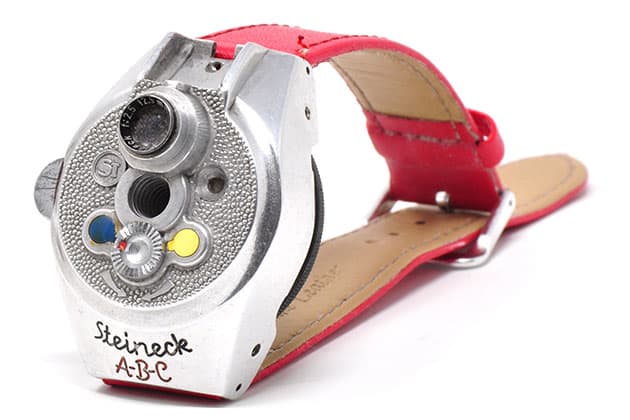Some collectable cameras are still usable. Some usable cameras are eminently collectable. But sometimes you come across a camera that for shooting purposes is impractical, not to say downright useless, yet you find it strangely attractive. You know you’ll never take pictures with it, yet you want it – if only to look at it, play with it and secretly fondle it. If you find yourself in this predicament, beware. You might be turning into a camera collector. If all this sounds alien to you, the best bet is to skip the next six pages. If, however, you feel a certain affinity with cameras that are oddly obscure or weirdly wonderful, then read on.
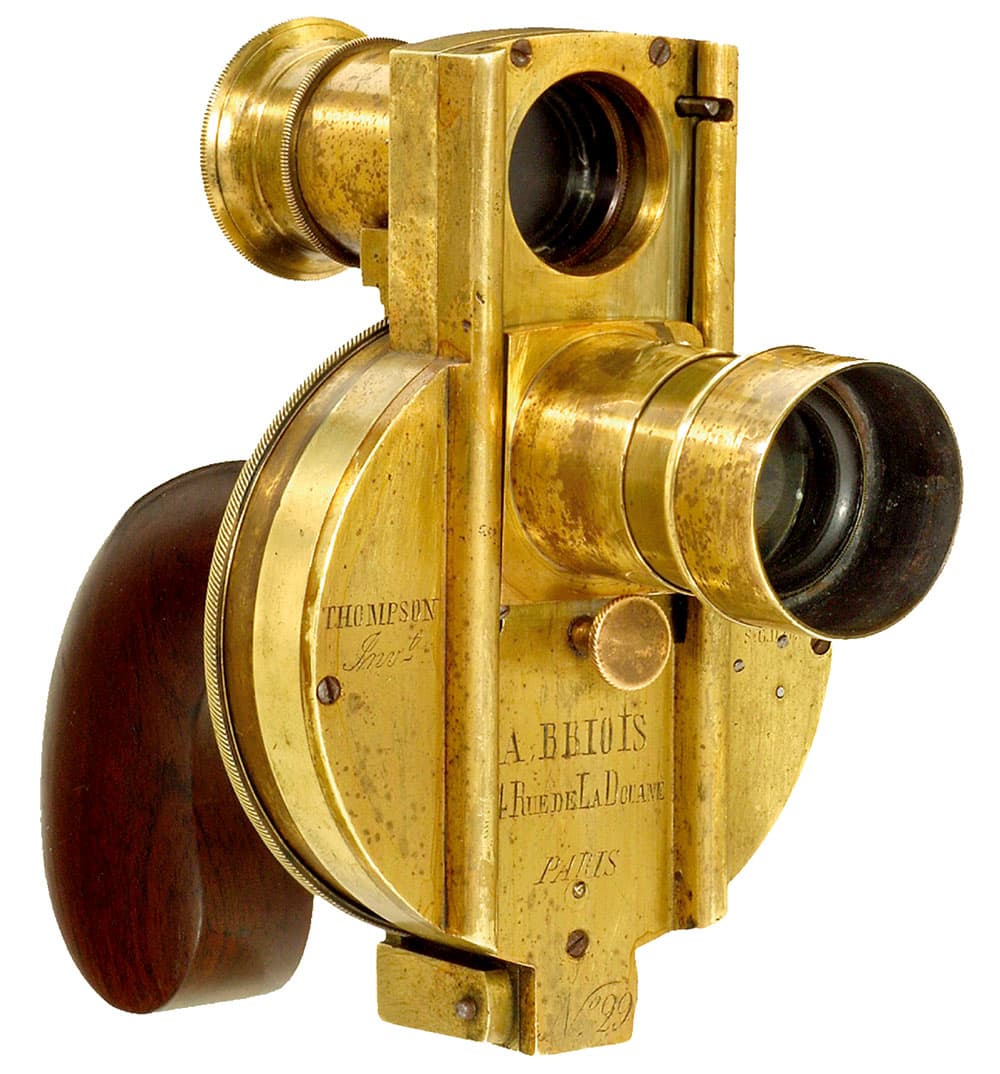
Thompson’s Revolver Camera bore only a passing resemblance to an actual gun. © 2018 BY AUCTION TEAM BREKER, COLOGNE, GERMANY (WWW.BREKER.COM)
1862 Thompson’s Revolver Camera
Designed in England and built in France to loosely resemble a revolver, the lens on this wet-plate camera slid up and down on brass tracks. At the top of its throw, it lined up with a ground-glass focusing screen covered by a magnifier. As a trigger-like catch was pressed, the lens dropped to its lower position, which aligned it with a 7.5cm circular photographic plate, just as the single-speed rotary shutter was released to shoot the picture. The plate then rotated through 90°, ready for the next exposure.

The Stirn was designed to be worn under a waistcoat. Credit: John Wade
1886 Stirn’s Patent Concealed Vest Camera
Pandering to a craze that began in the late 19th century for hidden cameras, the German Stirn was made to be worn under what Americans call a vest and what we might more readily refer to as a waistcoat. The lens poked through a buttonhole and the shutter was released by pulling a piece of string that led from the camera to a convenient pocket. Six pictures could be shot consecutively on a circular glass plate which was rotated between exposures by a knob disguised as a waistcoat button.
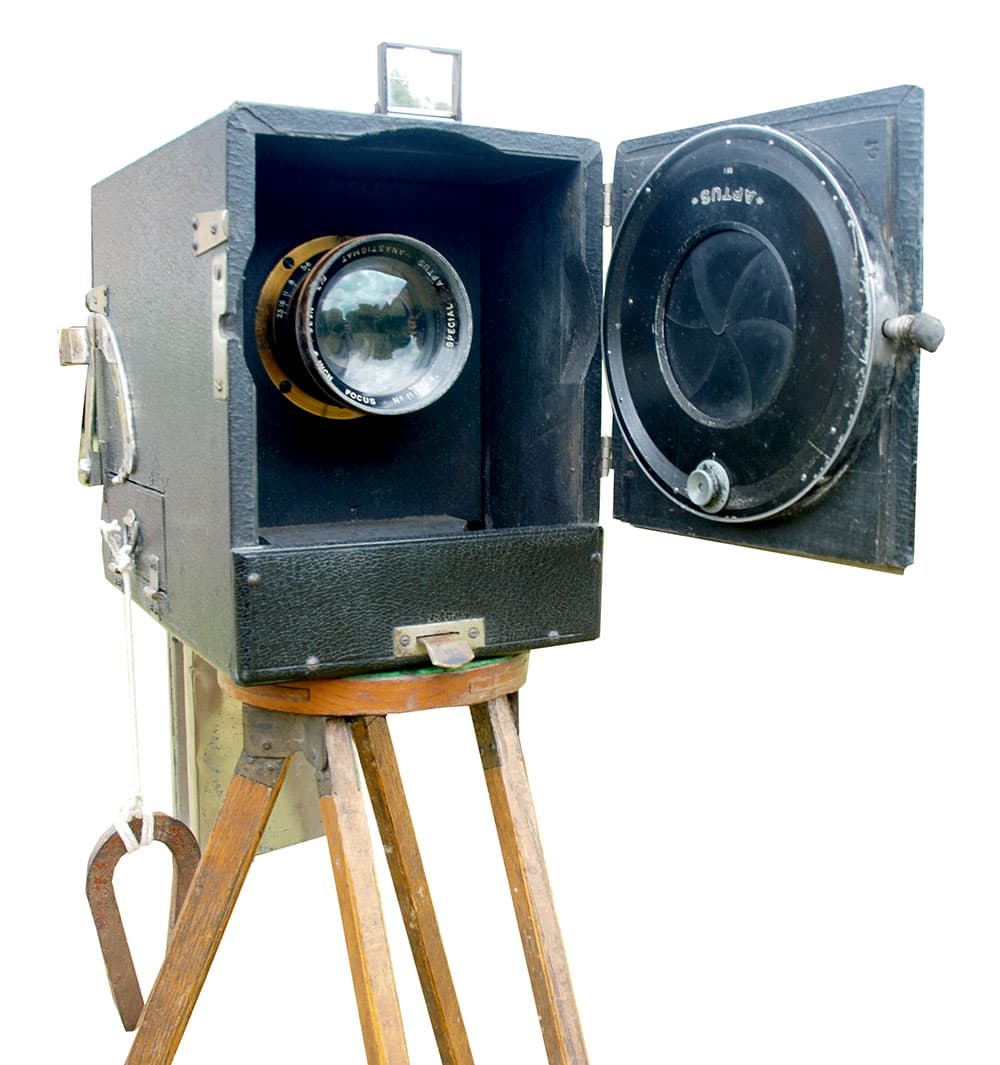
The Aptus shot and processed tintype images in only a few minutes. Credit: John Wade
1895 The Aptus
First made to take ferrotype or tintype metal plates, versions of the English Aptus, which began in 1895, were made well into the 1950s. The model here hails from 1922. Plates were held in the base of the camera, then lifted into the shooting position by a swivelling arm with a rubber sucker on its end, controlled by air sucked into, or expelled from, a rubber bulb at the end of a tube. After exposure, the plate was released to fall into a tank of one-shot developing and fixing solution beneath the body. Minutes later, the developed picture on the metal plate was retrieved from the tank using a magnet.

In 1900, the Mammoth was the world’s biggest camera. Credit: John Wade
1900 The Mammoth
The world’s biggest camera was built in America to photograph what the Chicago and Alton Railway Company called ‘the handsomest train in the world’. The camera was 20 feet long, with specially strengthened rubber bellows. Its plate holder used a roller blind made from 80 square feet of ash wood. The camera weighed 1,400 lbs and took 15 men to operate. Plate development used 10 gallons of chemicals. The picture it shot won the Grand Prize of the World for Photographic Excellence at the 1900 Paris Exposition, after which the Mammoth was dismantled and never seen again.
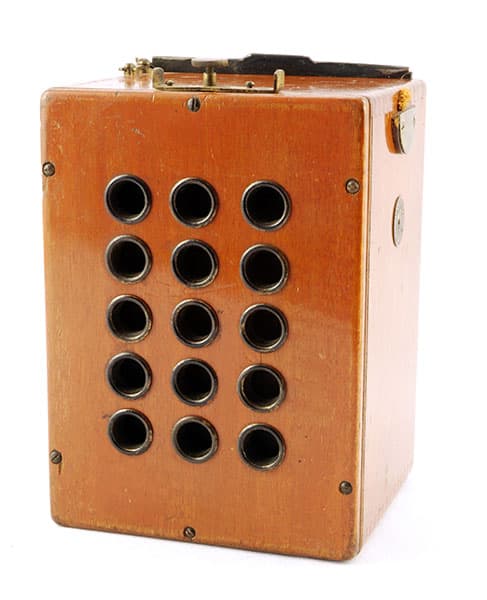
The Royal Mail Stamp Camera, which produced 15 postage stamp-sized pictures. Credit: John Wade
1907 Royal Mail Stamp Camera
All cameras have at least one lens. Some have more. The Royal Mail Camera had 15. This was a small, box-shaped mahogany plate camera, made in England by W Butcher & Sons. It produced 15 identical portraits in three rows of five on quarter-plate size glass plates. Each of the individual images was about the size of a postage stamp and special masks were available to make a contact print from the plate look like a sheet of postage stamps; hence the name of the camera.

The Hythe Machine Gun Camera was made to train pilots in air-to-air combat. Credit: John Wade
1915 Mark III Hythe Machine Gun Camera
When training First World War pilots in air-to-air combat, it was obviously impractical to use live ammunition for fear of shooting down an aircraft. That’s why English manufacturer Thornton Pickard was asked to build this camera. It looked and handled exactly like a Lewis machine gun of the period. But as the trigger was pulled it shot pictures on special rollfilm, courtesy of a 300mm f/8 lens in the barrel. Once developed, the images indicated how accurate the airman had been in aiming the camera and, if it had been a real gun, the likelihood of him having shot down an enemy aircraft.

The Maton with its purpose-made film cassettes and information book. Credit: John Wade
1930 The Maton
This unusual French camera was made of Bakelite and held by a handle on the back into which three fingers could be hooked. Inside, an angled mirror reflected the image from the lens through 90° and down onto paper-baked film running along the base of the body. It shot 24 exposures 24x30mm. Turning a side-mounted crank advanced the film and fired the shutter in sequence. Shutter speeds of 1/25–1/100sec were adjusted by a control above the lens, with a lever to adjust apertures beneath. With the addition of a suitable light source, the camera also acted as a projector.
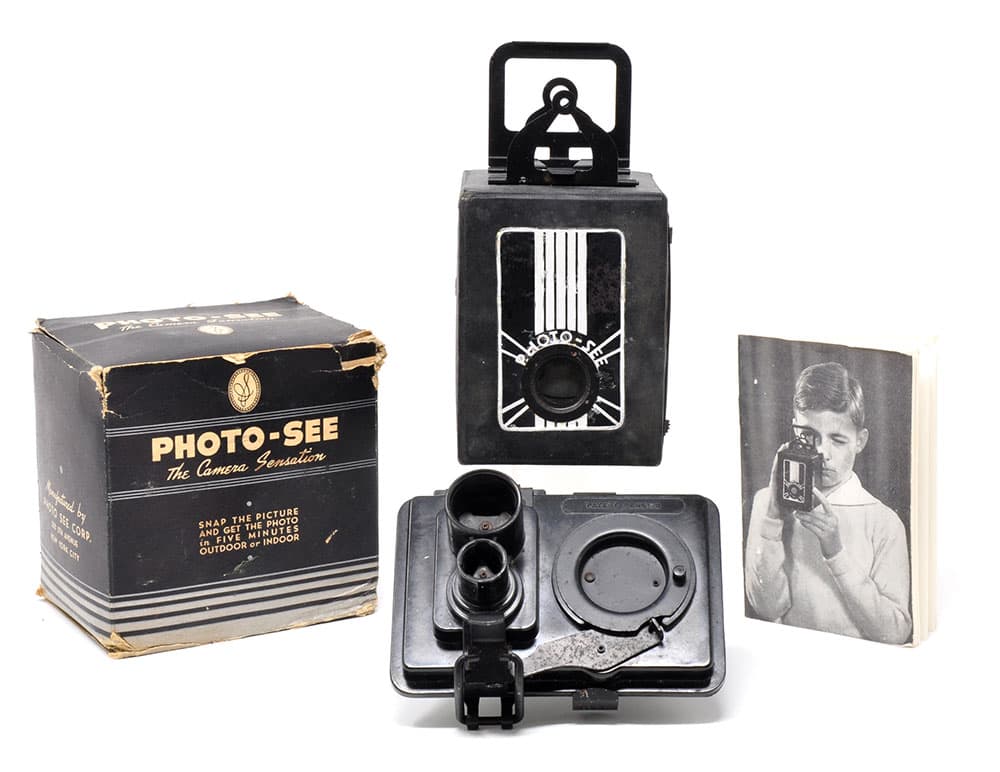
Photo-See camera, with its developing tank, original box and instruction book. Credit: John Wade
1936 Photo-See
Twelve years before Polaroid’s first instant picture camera, the American Photo See Corporation made this small box camera, which shot and developed an image in five minutes. It did so by encasing single sheets of film in light-tight sleeves. With the camera closed, the film was extracted from the sleeve by a mechanism on the back of the body, the picture was taken, and then the film was reinserted into its sleeve. Using a similar process, the sleeve was then placed in the camera’s special developing tank and processed by chemicals poured into and out of spouts on the front of the tank.
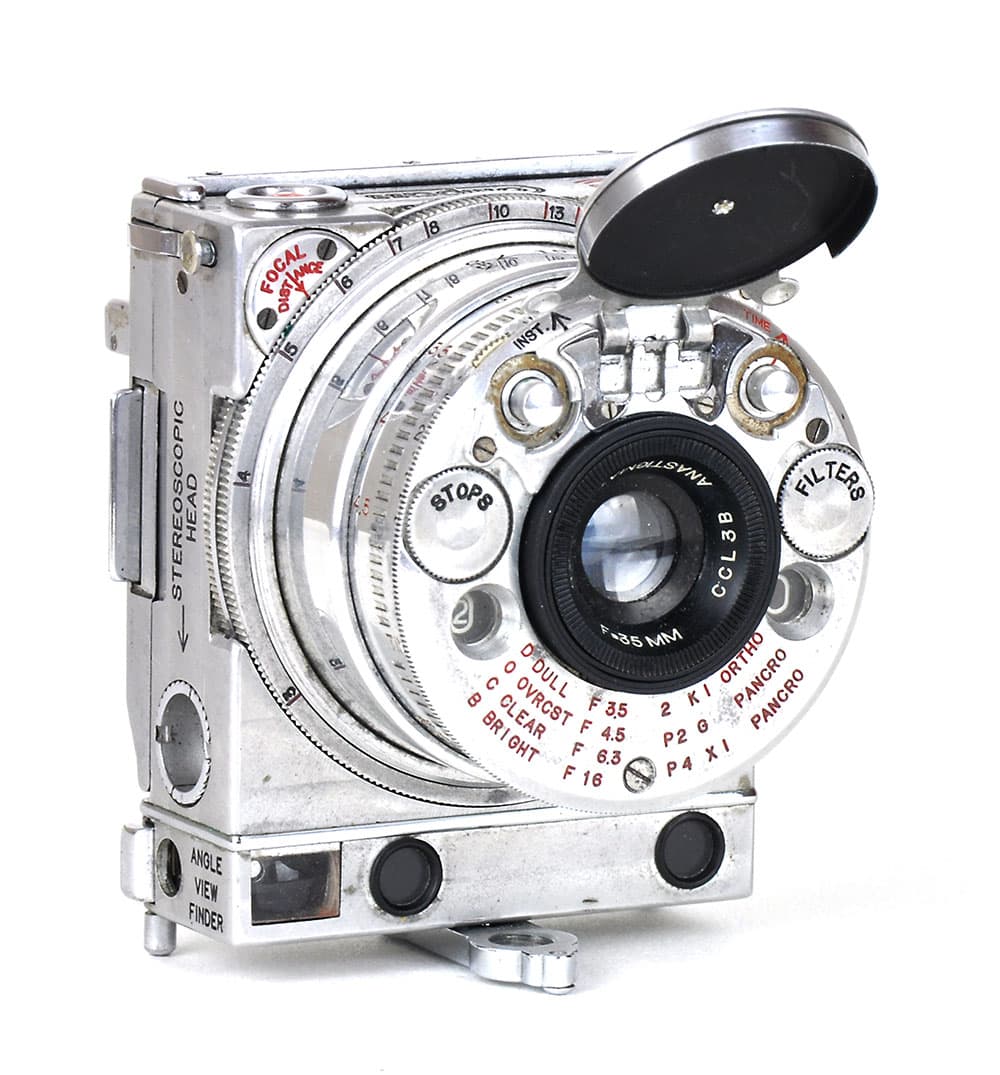
The Compass was one of the most complicated subminiature cameras ever made. Credit: John Wade
1937 The Compass
Designed in England, but built in Switzerland by Swiss watchmaker LeCoultre, the Compass measured a mere 6.5×2.5×5.5cm. But into those trim dimensions, it packed three built-in filters, a collapsible lens hood, spirit level, rangefinder, special heads for panoramic and stereo photography, an Anastigmat 35mm f/3.5 focusing lens that stopped down to f/16, shutter speeds of 4.5-1/500sec, a ground-glass focusing screen under a hood on the back, right-angle viewfinder, depth of field scale and a built-in exposure meter. It was super-sophisticated, but overly complicated to use and lasted only a few years.
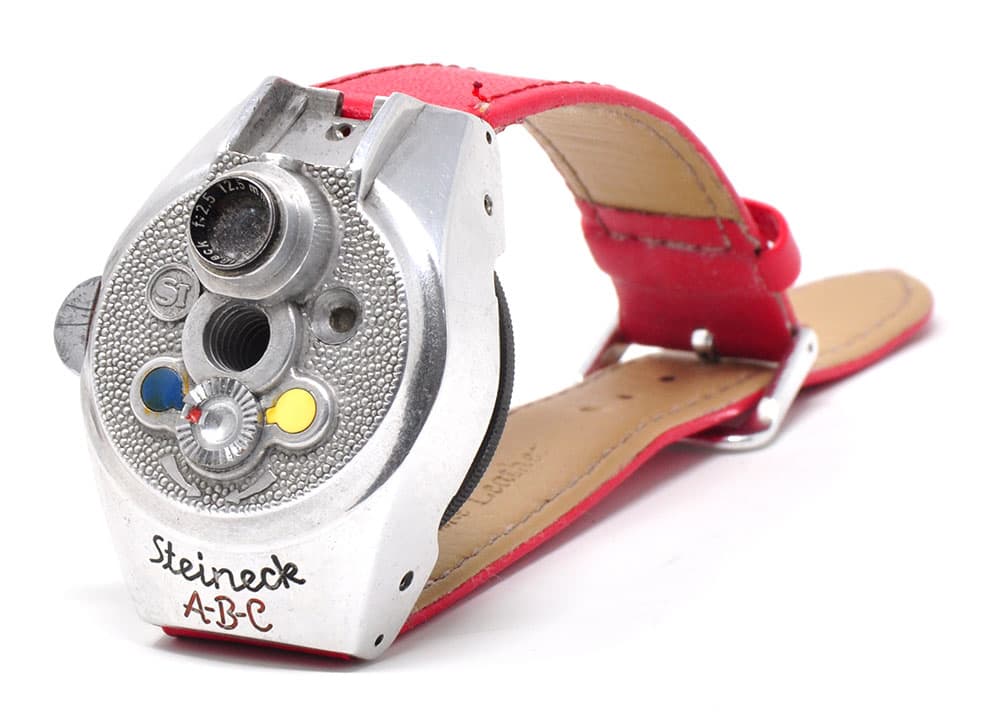
Steineck ABC, designed to be worn like a wristwatch. Credit: John Wade
1948 Steineck ABC
This was a German camera, designed to be worn on the wrist like a watch. It had a tiny Steinheil 12.5mm f/2.5 lens at the 12 o’clock position that shot eight circular images, 5.5mm in diameter on a 25mm disc of film. Film discs could be cut from normal 35mm film, using a special punch. After the single speed shutter was released by a button on the case where a watch’s winder would be, the film disc automatically rotated ready for the next exposure. When the camera was launched, clip-on filters, close-up lenses and even a miniature enlarger were available.

The Tom Thumb combined a camera with an old-time radio. Credit: John Wade
1948 Tom Thumb Camera Radio
Is it a camera, or is it a radio? Actually it’s both. The American Automatic Radio Manufacturing Company built this hybrid, using a four-valve radio as the basis in the days before transistors were commonly available. The radio received medium wave only, tuned by a knob on top and a needle passing along a numbered scale on the rear of the body. The camera was a simple snapshot type with two lenses: one to shoot the picture, the other to reflect its image to a viewfinder on the top of the body.

The Lucky Strike was designed as a spy camera for use in the Cold War. Credit: John Wade
1949 Lucky Strike
Many disguised cameras were made as novelties, rather than for true espionage use. This one, made by the American Mast Development Corporation, was the exception. It was developed for the US Signal Corps, designed so that a real Lucky Strike cigarette packet could be taken apart and then re-glued around the camera body, with the lens behind a shutter in the side. False cigarettes protruding from the top of the packet controlled various functions and the shutter was released by a minute button hidden under the wrapping. It’s doubtful the camera got beyond the prototype stage.
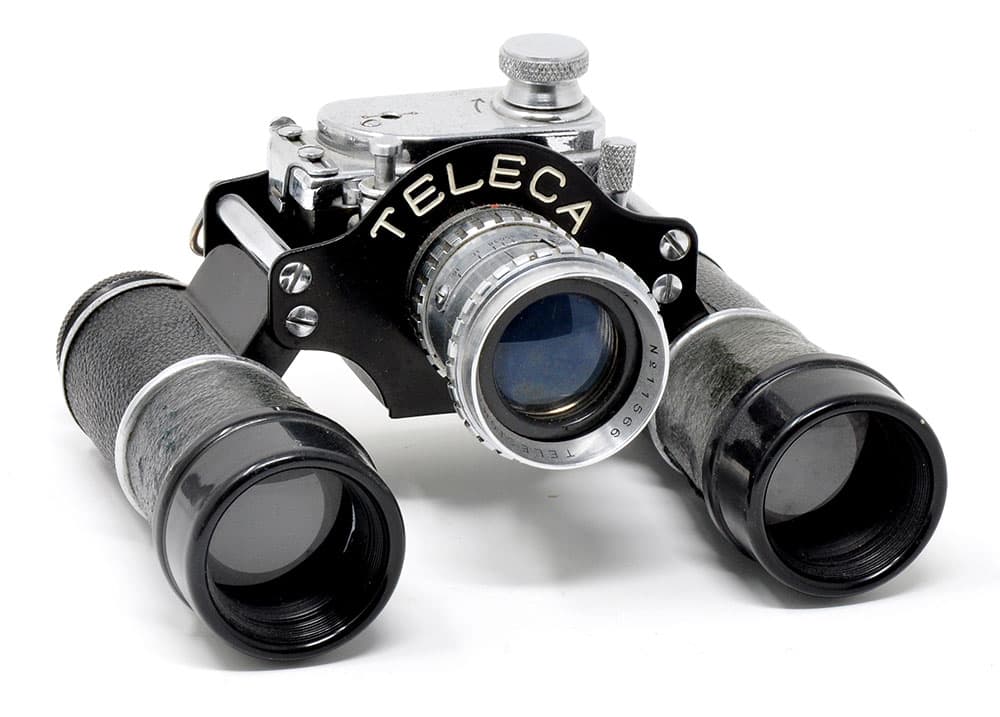
The Teleca combined picture taking with binoculars. Credit: John Wade
1950 Teleca
Coupling a camera with binoculars was not uncommon, especially in the era when subminiature cameras were all the rage. This one, made in Japan by the Toko Photo Company Ltd, took 16mm film in its own unique twin cassettes. Rings on the rear of each lens focused the binoculars, which acted as the viewfinder. The camera was mounted above the binocular lenses with its own lens between them, focused by a ring on the barrel. Behind that, another ring set apertures of f/4.5-16. Shutter speeds of 1/25-/1/100sec were set on a sliding control beside the shutter release. This was one of the better subminiature binocular cameras.
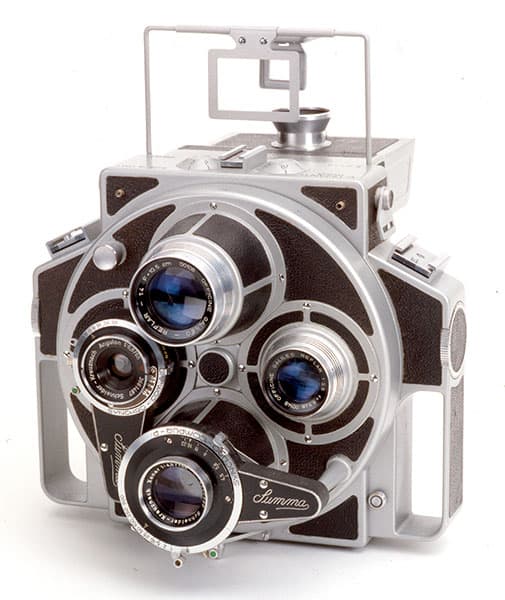
The Summa Report was an unusual press camera from Italy. Credit: John Wade
1955 Summa Report
When it came to camera manufacturing countries, Italy was never up there with the greats. The Italian Cesare Tiranti company, however, had a good try with this, built originally as a press camera. It featured four lenses on a rotating turret: two shot the pictures, the other two changed the scene in the viewfinder appropriately as each was rotated into position. The shooting lenses offered a choice of a Xenar 105mm f/3.5 or f/4.5 standard or an Angulon 65mm f/6.8 wideangle, both with built-in Synchro-Compur shutters. The camera shot 6×9 cm images on rollfilm, film packs or plates.

The French Mundus Color was a still camera that used 8mm cine film. Credit: John Wade
1960 Mundus Color 60
In 1932 Kodak introduced Standard-8 cine film. It was actually 16mm wide, and ran though a movie camera twice. Split down the middle with the resulting two strips joined after processing, it produced 8mm images. The French-made Mundus used the full 16mm width of Standard-8 to shoot 8x14mm still images, up to 350 to a reel. A lever on the side advanced the film and tensioned the shutter at the same time. With a Som Berthiot 20mm f/2.8 lens focusing from 50cm to infinity and a shutter speeded 1-1/300sec, the result was an unusual but sophisticated subminiature camera.
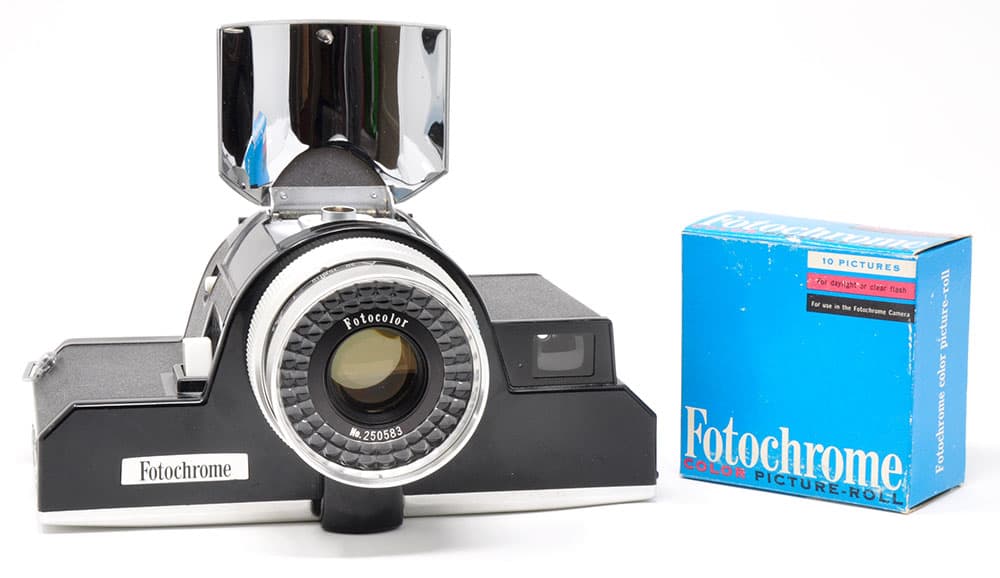
The short-lived Fotochrome, with a box of its film that produced direct positive colour prints. Credit: John Wade
1965 Fotochrome
Although made by Petri in Japan, the Fotochrome was designed by an American photofinishing company to use its own direct positive colour film. The camera’s unusual pyramid-shaped body featured a lens at the top which used an internal mirror to reflect the image down to the film running along the base of the camera. Pressing a button on the side flipped up a reflector for a built-in flashgun. Exposure was automatic thanks to a large selenium cell meter surrounding the lens. Misjudged marketing led to the camera’s downfall.

The Russian Photosniper was used like a rifle. Credit: John Wade
1965 Photosniper
The Russian KMZ factory began mounting cameras on gun stocks in 1944. By 1965 the early designs had evolved into the Photosniper range. Several models were made in the following years; this one is the FS-12 from 1982. It used a modified Zenith single lens reflex with a Tair-3S 300mm f/4.5 lens, all mounted on a gun stock whose trigger was linked to the shutter release in the base of the camera. A knob set into the front of the stock focused the lens, and an adjustable shoulder pad at the rear completed the resemblance to a rifle.

The Mick-a-Matic, made to take 126-size Instamatic film. Credit: John Wade
1971 Mick-a-Matic
Mickey Mouse, one of the 20th century’s most iconic symbols, appeared on many cameras. But with the Mick-a-Matic, made in America by Child Guidance Products Inc, Mickey didn’t just appear on the camera, his head was the camera. His nose held the lens, there was a viewfinder in the middle of his forehead and flashcubes could be attached to the top of his head. Pictures were taken on 126 cartridge film, introduced by Kodak for its Instamatic cameras in 1963. In early models, the shutter was released by pulling Mickey’s ear. Later models had a separate lever to the side of his head.
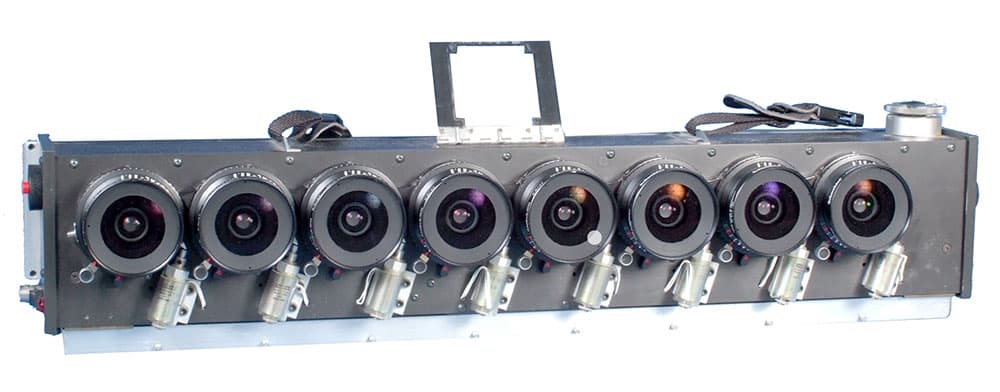
The Nimstec produced stereo images by using eight lenses. Photo courtesy of Tim Goldsmith
1980 Nimstec lenticular camera
It is generally agreed that stereo cameras need two lenses, but the American Nimstec company preferred more. In 1982, when the company launched the Nimslo camera as an easy way to achieve stereo images using lenticular technology, four lenses were used. A few years previously, with this prototype, they went for eight lenses, to take eight 6x6cm images simultaneously on 120 rollfilm. Each lens was a Schneider Super Angulon 47mm f/5.6 with its own shutter speeded 1–1/500sec. The shutters were fired manually via a linkage on the base of the camera or by battery-powered solenoids.

The Canon Epoca, a curious design from the 1990s. Credit: John Wade
1992 Canon Epoca
Even as late as the 1990s, when most cameras conformed to a few basic styles, some manufacturers still went for something different. In Japan, Canon produced this strange beast, shaped like a long tube with a hinged lens cap. Opening the cap revealed a 35-105mm zoom lens in the tube and a flashgun on the inside of the cap. The camera featured automatic exposure and autofocus with a battery-driven motor drive. A sliding catch on the top changed the eye-level viewfinder to a tiny waist-level finder. Controls at the back of the tube released the shutter and zoomed the lens.
Further reading:
The worst digital cameras ever made
Best vintage digital cameras to buy
The most expensive cameras ever released

